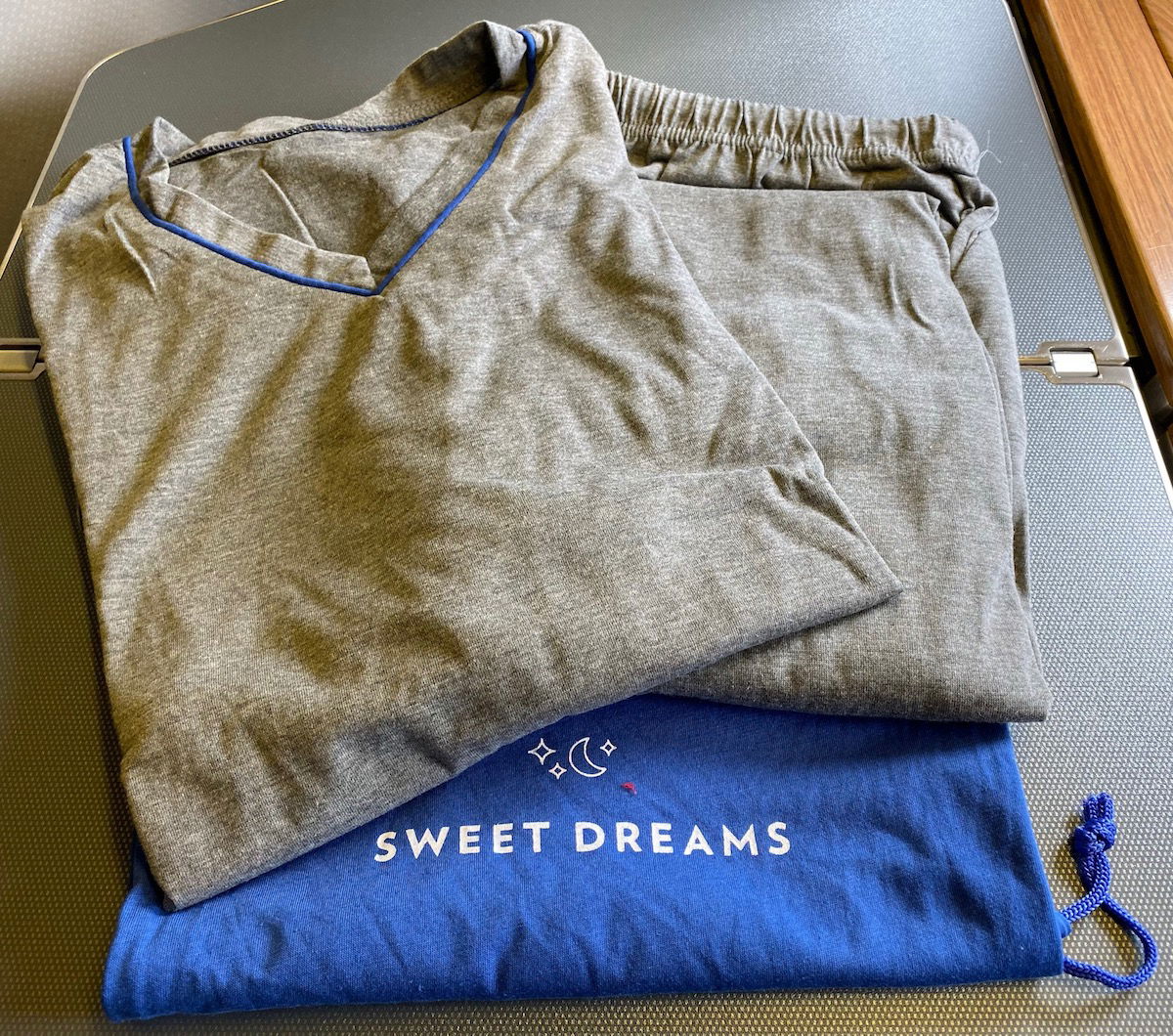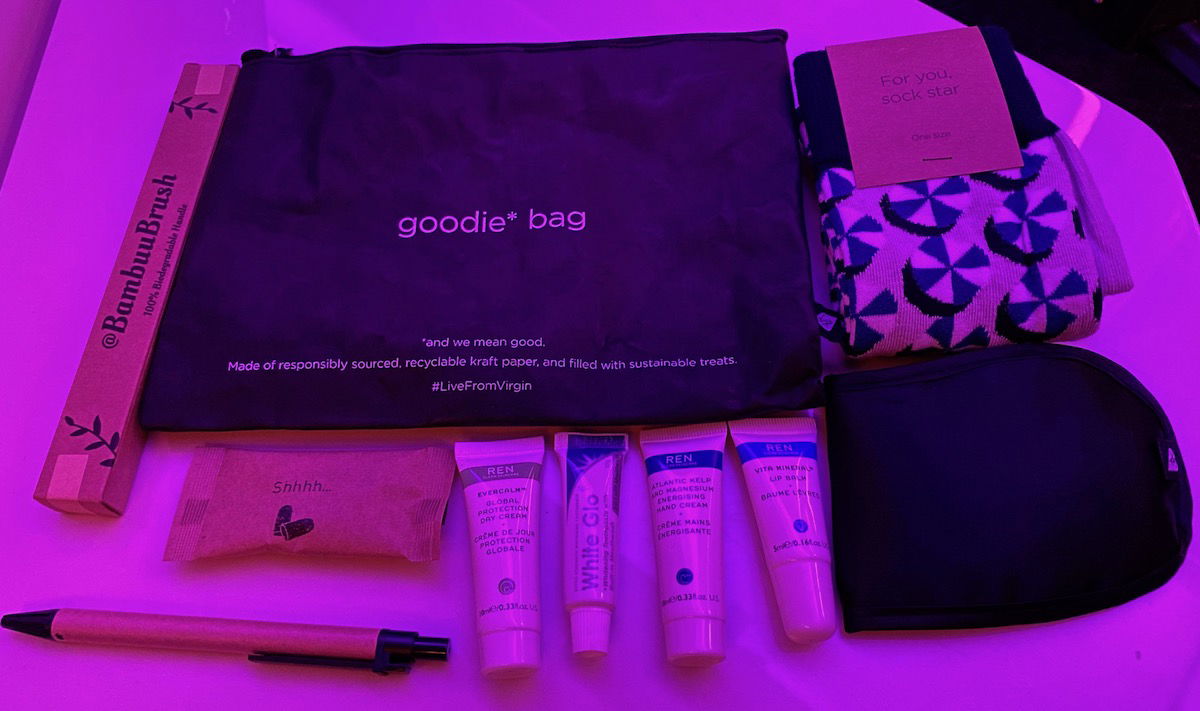Sustainability is a big focus for airlines nowadays, and at American Airlines that’s extending to first class pajamas…
In this post:
American’s new pajamas are made of plastic bottles
@xJonNYC flags that American Airlines will be introducing new pajamas for international first class passengers as of January 10, 2022:
- These are designed by RECLINER, which I’ve never heard of
- The focus is on sustainability, and the pajamas are made of recycled plastic bottles, blended with cotton, “to deliver soft, breathable, sustainable pajamas”
- This program will result in daily saving of 4,821 bottles from landfills, resulting in 33 tons annually
- There will also be new slippers, which will be wrapped in recycled paper rather than plastic wrapping

I’m kind of intrigued. We’ve seen different sustainability measures from airlines, from Alaska Airlines serving boxed water, to Virgin Atlantic having fully recycled amenity kits, to American Airlines serving meat and cheese not fit for human consumption (okay, I made up that last one). But clothing made largely of recycled plastic bottles? That’s something I don’t think we’ve seen from an airline before.

I’m curious if the quality of the new pajamas is as good as the old ones, or if this is a downgrade in the name of sustainability. If the latter is the case, then I’d argue this doesn’t do a whole lot to help the environment at all — if they’re low quality, people are unlikely to take the pajamas home and reuse them.
Meanwhile Emirates claims that its pajamas are “moisturizing,” though I’ve yet to figure out what that means, even after having picked up several pairs.
American’s new “Big Sur After Rain” scent
Also as of January 10, 2022, American Airlines will introduce a new aircraft soap and scent spray. Wait a second, American has an aircraft scent spray?! Anyway, the new scent will be “Big Sur After Rain,” and it will align with the D.S. & Durga scents featured in lounges and amenity kits. The “Big Sur After Rain” scent is described as featuring:
- Top notes of coastal rain and eucalyptus shoots
- Hearty notes of magnolia and pacific spray
- Base notes of eucalyptus wet leaf and wet wood
Yeah, I’m sure I’ll pick up on all of those on my next American Airlines flight. 😉
But in all honesty, have I been living under a rock, or since when does American have an aircraft scent spray? Is this actually sprayed in the cabins, or is this just something they use in place of a coffee grounds after someone abuses the lavatory?
Bottom line
American Airlines will shortly be introducing new first class pajamas, made largely of recycled bottles. I’m curious to put on a pair some day, and wonder if they’re actually as comfortable as the old ones. If so, awesome. If not, single use pajamas don’t seem terribly “sustainable” to me.
Anyone have any guesses as to how American’s new pajamas will be?





I recently flew from Delhi to NYC on AA first, and experienced these pajamas. I was surprised to find them exceptionally comfortable and even sort of cute. They were lightweight so you didn't get hot, soft and smooth. My husband and I both ordered more from the company...but alas they have a different style. ok, but not as good as the ones on the plane. Where can we get them now!
Just tried the new Recliner pajamas, and they were softer, lighter and more comfortable than the Casper ones. Took me by surprise honestly.
I like the Casper pajamas. I’m in some right now at home. I’ve given away several sets to family and friends from flying Flagship back and forth to Brazil 10 times last year. Why ruin a good thing? Since when is cotton not sustainable?!
Never understood people getting excited about pajamas on a plane. Just wear something comfortable and you will be fine. I haven’t worn pajamas since I was 10 years old and can’t imagine any adult wanting to do so, especially in public.
This one brilliant move by AA may get me back on international flights. COVID be damned. Sustainable pajamas? Can't wait. My only concern is if I'll be able to sleep in woke sleepwear.
How about just serving us hot food on domestic business flights!
Marketing ploy aside, in lieu of the new "signature scent", why not simply use (cheap, reusable, natural) activated charcoal to remove odors?
Plan pandering to sheep who don't know any better.
Have you seen the condition of the lavs of American carriers? I wouldn’t change my clothes in there if you paid me.
What Alex said. Would it not make more sense for loungewear to be offered in the Flagship lounge where one could change in more comfortable and cleaner (?) conditions.
And dress in PJ from the lounge to the gate?
And still in PJ from arrival to immigrations to another lounge or hotel or home?
LOL.
And @Alex, I'm sure if someone offers you a million dollar to do it, you would do it.
Thiese hideous single-use airline Pyjamas are worthless and not sustainable at all.
And especially not if they are made out of plastic which has an estrogeneous effect that lowers fertility and testosterone levels.
In First Class I expect only the finest materials such as silk.
The only thing I smell are turkey pastrami sandwiches.
The use of PET bottles for manufacturing fibres is actually more accurately termed, downcycling. Most garments that contain polyester have already utilise a fraction, if not 100%, recycled PET (either from bottles or from internal scrap). Textured and fully drawn PET yarn is mixed with cotton at different proportions to add strength and longevity. This is nothing new nor unusual. Asia (primarily China and India) has PET bottle recycling rates exceeding 97% (unmatched with other...
The use of PET bottles for manufacturing fibres is actually more accurately termed, downcycling. Most garments that contain polyester have already utilise a fraction, if not 100%, recycled PET (either from bottles or from internal scrap). Textured and fully drawn PET yarn is mixed with cotton at different proportions to add strength and longevity. This is nothing new nor unusual. Asia (primarily China and India) has PET bottle recycling rates exceeding 97% (unmatched with other regions of the world), simply because of the demand for PET for the large fibre and textiles market. This is the reason why regulations in China and India prevent the use of toners for beverage bottle tinting. Down cycling is actually a big shame since textiles and garments end up in landfills at the end of life anyways. In the EU, chemical recycling (SSP) enables the conversion of bottles into bottles, keeping the PET in the loop. North America tends to have a poor recycling record so isn’t worth mentioning. Anyways - the use of PET from discarded bottles for spun fibers is common. I doubt anyone can tell the difference and nor would I expect to observe a difference in cost. A nice marketing gimmick though.
Common blends for polyester:cotton include 80:20, 60:40 and 50:50, 50:60 and 20:80. Most sports gear are made from 100% PET. This yarn is textured differently to impart the greater moisture wicking, greater water resistance and smooth feel common of sports clothing.
1000% this comment. Calling these items sustainable is just spin by the petrochemical industry. We need to get plastic bottles out of production.
Actually that’s not what I meant. Plastics are necessary and key to progress. By far, the use of plastics, where they are necessary, is the most sustainable option. People tend to think that paper packaging and glass bottles are more friendly to the environment. Sadly, that’s not true when you look at the overall life cycle. Plastics are amazing materials, with few competitive alternatives. The problem is around the economics of disposal and recycling. Plastic...
Actually that’s not what I meant. Plastics are necessary and key to progress. By far, the use of plastics, where they are necessary, is the most sustainable option. People tend to think that paper packaging and glass bottles are more friendly to the environment. Sadly, that’s not true when you look at the overall life cycle. Plastics are amazing materials, with few competitive alternatives. The problem is around the economics of disposal and recycling. Plastic bottles are actually much more sustainable compared to any feasible alternative. Current innovations and developments focus on keeping the existing material in the loop.
My earlier comment meant that the the use of PET from bottles to make fibers is nothing new. Although the use of used bottles for polyester fibers extends the life of the material, it isn’t the best use. With chemical recycling, we can now convert bottles into bottles. That is definitely the future. I have great respect for the petrochemical industry since without them civilisation would not have advanced.
My point is that companies such as AA are marketing a very common economy as something novel and unique. It’s not a lie but it’s also nothing new. Chances are all their earlier apparel already contained bottle grade PET; it just wasn’t a big deal until now.
@Levy Flight
Calling food organic is also a spin by the farmers and agricultural industry.
I've never once in my life seen beef made out of synthetic substances or vegetable that isn't hydro-carbon.
Or they only mean pesticides, which by the way some 'organic' pesticides are more dangerous than chemical pesticides. (But less effective so they spray it even more, LOL)
The real sustainability move would be to eliminate them completely. Only mentally and physically soft people think they need soft pajamas on an airplane.
@jcil
You make a point.
But the real sustainability move would be to eliminate premium cabins completely. Only (rich) mentally and physically soft people think they need lie flat seats on an airplane.
Would you agree?
And by any chance you're into crypto mining?
“wet woof”? Does it smell like a wet dog?
Hello Ben.
Please let us know whether the pajamas are made of cotton or synthetic fibers and how much %. And where it was made.
Many Thanks.